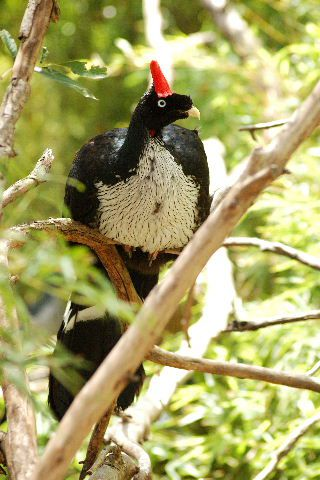Description: The Horned guan is an impressive, unmistakable bird that is named for the unusual red “horn” of bare skin at the tip of its head. Adults sport a horn that averages between 1.6 – 2.4 inches (4 – 6 cm) in height. This large cracid is glossy black above, with a blue-green sheen. The foreneck, breast and upper belly are mostly white, with black flecks. The lower belly and flanks are brown. A striking, white band is near the base of the tail. Horned guans also have a small red dewlap (loose skin hanging under the neck). The legs are red, iris is white and the bill is yellow. Sexes are alike, however it has been reported that the lengths of tarsus, wing, tail and horn are somewhat longer in males. Vocalizations and behavior can be used more accurately for the identification of males and females.
Size: Horned guans stand approximately 33 inches (84 cm) tall, and are about the same size as an American turkey
Behavior: Horned guans are poor fliers. They are very arboreal, spending most of their time sleeping,
preening and eating. They descend to the ground each day to dust-bathe (a characteristic of many Galliformes). It is believed this keeps the feathers in good condition, removes parasites and helps maintain oil in the plumage. It is also part of the courting process.
Diet: They feed on a variety of fruit, flowers, and leaves. Although considered frugivores, some invertebrates and small vertebrates may occasionally be part of their diet.
Communication: Females produce more guttural types of calls than the deep booming vocalizations of the males. Other sounds include bill-clacking, snorts and clicking. Sounds help identify the sex of this species.
Reproduction: Horned guans have a polygynous mating pattern (males may have access to 3 – 5 females during this process). Males establish courtship territories that are defended by various displays (beating of the wings, stretching the neck, spreading the tail, etc.) but with little or no direct physical contact. Most nests are in tall, somewhat isolated trees, usually near a water source. Leaves, bromeliads, orchids and vines are piled up and then slightly depressed by the weight of the guan. Nests are approximately 12-14 inches (30-36 cm) wide and 2.5 inches (6.5 cm) deep, which seems quite small for the large cracid. A clutch of two white eggs is laid. The incubation period is estimated to be 35-36.5 days. Horned guans feed leaves and fruits to their young.
Habitat/range: Lives in cloud forests in Guatemala and the neighboring Mexican state of Chiapas.
Status: Classified as Endangered (EN) on the IUCN Red List; CITES Appendix I.



